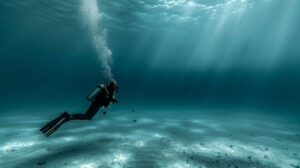Down, down, down, to the bottom of the sea. The depths of the oceans and the spots for the best diving in the world are almost endless. And that’s exactly what makes them so fascinating. With every inch you dive deeper, you discover new, often breathtaking parts of the sea. That is why experienced scuba divers, who already feel comfortable underwater, typically ask themselves one question, “How deep can a human dive?”. Well, today we will literally get to the bottom of this question.
In this article, you will get answers to the following questions:
- How deep can you scuba dive without scuba gear?
- How deep can you dive with gear?
- What is the deepest human dive with gear?
- And what are the risks of diving too deep?
How deep can you scuba dive without scuba gear?
You’ve probably already had your first diving experiences without scuba equipment as a child, whether in the ocean or in the swimming pool. Wherever you may have been, you surely know how it feels to jump into the water, hold your breath and dive south a few inches.
In case you have reached a depth of 60 feet (18.28 meters) on the diving table without the use of a breathing apparatus, you can officially call yourself a “free diver” as these are the two requirements that define free diving. But what exactly happens with the body once you start diving without any equipment, and how deep can a human dive? Let’s take a closer look.
What Happens in Your Body When You Dive?
First, learning how to dive without gear is a sport that definitely takes practice and a lot of experience. After all, you are diving in the deepest waters without any breathing apparatus to supply you with oxygen. This makes free diving a risky activity that requires adequate physical, mental and gear preparation.
The longer your dive, the more heat your body loses. If you are looking for the best wetsuit for diving, whether it is the best wetsuit for women or men, take a look into the wetsuit temperature guide.
During free diving, several processes take place in the body to help it adapt to the environment. First and foremost, the pulse decreases by up to 25%. The decrease in heart rate is the result of the mammalian dive reflex.
This is a physiological response in the human body that naturally occurs when the face is immersed in water. You can think of it as an adaptation that helps the body conserve oxygen, helping you to stay underwater longer. Experienced free-divers can even decrease their heart rate up to 50% allowing them to stay underwater even longer.
At the same time, the blood vessels in your extremities like the arms and legs are narrowed when diving, redirecting the blood to the vital areas such as the heart and the brain. Also, the lungs expand to compensate for the increased water pressure that acts on your body.
The 6 Categories of Free Diving
Next to understanding the physiological changes that occur when free diving, one question remains: “how deep can a human dive?”. To answer this question, one most differentiate between the different categories of free diving.
Some main free diving categories are:
- Constant Weight with Fins (CWT)
- Constant Weight without Fins (WNF)
- Free Immersion (FIM)
- Variable Weight (VWT)
- No Limits (NL)
- Static Apnea (STA)
The current world record in the category “Constant Weight with Fins” (CWT) was set by Alexey Molchanov in August 2021 at 423 feet (128.93 m). In the category “No Limits” (NL), Austrian Herbert Nitsch currently holds the record at 702 feet (213.97 m).
Fascinating, isn’t it? Being able to reach such depths requires divers to hold their breath – for a very long time. When it comes to holding breath underwater, Aleix Segura holds the record at 11 minutes and 54 seconds, set in 2016.
Now that we answered the question “How deep can you dive without any equipment?”, let’s take a look at how deep can a person dive with gear.
How deep can you dive with scuba gear?
In contrast to free diving, scuba diving allows divers to breathe underwater using an oxygen tank, strapped onto the diver’s back. Therefore, “scuba” stands for “self-contained underwater breathing apparatus” – in case you didn’t know.
But even though scuba gear allows you to breathe underwater, that doesn’t mean you can actually reach the bottom of the sea. There are several factors that come into play.
Deepest Human Dive With Gear
According to the “Professional Association of Diving Instructors” (PADI), the deepest estimated depth recreational scuba divers can reach is at roughly 130 feet (39.62 m).
Experienced divers that have the right equipment can easily reach greater depths as well, but in both cases, ascending back to the surface has to occur very slowly by making decompression stops in order to prevent decompression sickness.
And what about the maximum depth any human has dived to with scuba gear? Here, Ahmed Gabr holds the world record at a stunning depth of 1,090 feet (332.23 m) since 2014. He set the record in the Red Sea in Egypt and reached the world record depth after 12 minutes.
However, the entire dive took him more than 14 hours, as this was the time spent on decompression stops on his way back to the surface.
And How Far Can You Dive?
Since not every scuba diver aims at setting up a new world record, most diving institutions have clear recommendations on how deep to dive.
Most diving institutions recommend the following depths:
- For adults who are not certified scuba divers and have no training, a depth of no more than 40 feet (12.19 m) is recommended.
- Adults with the basic open water certificate can increase the depth to 60 feet (18.29 m).
- Advanced divers with additional training on top can reach depths of 130 feet (39.62 m)
- Children with and without scuba certification should dive to a maximum of 40 feet (12.19 m)
- Teenagers who have an advanced scuba certification may dive to depths of around 70 feet (21.34 m), depending on their diving experience.
Choosing the Right Gear for Scuba Diving
Without going too much into the details of how much the scuba gear costs, the prize can vary widely depending on the brand, quality, and whether you’re purchasing a full set or individual pieces. Firstly, you need to decide between wetsuit vs. dry suit, but let me tell you: Drysuits are worth every Penny when in cold or icy conditions, but they are an investment.
You should understand the difference between drysuit and wetsuit first to see if it might not be better to think about what to wear under your wetsuit for warmth instead.
What are the risks of diving too deep?
It is absolutely crucial to understand the risks of diving with and without scuba gear. In general, the deeper you dive, the harder it gets for your body to adapt to the surrounding and with that the risks to your health increase.
The most frequent risks of diving too deep are:
- Decompression sickness
- Barotrauma
- Nitrogen narcosis
- Hypothermia
Decompression sickness: One condition divers frequently face is decompression sickness, which occurs when a diver ascends back to the surface too quickly. By ascending too quickly, the rapid decrease in water pressure can lead to nitrogen bubbles forming in the body that often cause joint pain, rashes and breathing difficulties.
Barotrauma: Next to decompression sickness, divers can experience a barotrauma when ascending too quickly. This type of injury can cause painful damages in the ears and lungs. So, make sure to always take breaks on your way back to the surface.
Nitrogen narcosis: Nitrogen narcosis is another risk divers may face when exploring the seas. When reaching deeper sea levels, divers start taking in more air and thus also more nitrogen. The high water pressure at deep levels then causes the nitrogen to be pushed into the bloodstream, which can directly affect the central nervous system and lead to symptoms of nitrogen narcosis.
The effects of nitrogen narcosis can already start at a depth of 100 feet (30.48 m) and leave the diver with similar symptoms to those of alcohol intoxication: feelings of euphoria, confusion, and impaired judgement.
Hypothermia: Of course, divers should always wear the appropriate wetsuit/dry suit when submerging in water. Diving too deep without the right suit to keep you warm can quickly lead to hypothermia. Signs of hypothermia include shivering, confusion, or even loss of consciousness.
Conclusion: How far can you dive?
Bigger, faster, better…deeper? As humans, we have the natural urge to always test our limits. Therefore, it is at no surprise that we also want to test ourselves when it comes to diving. Especially experienced divers often wonder, “how deep can you scuba dive?”.
How far you can dive depends on whether you dive with or without breathing apparatus. Diving without breathing apparatus is called free diving (once you reach a depth of 60 feet or 18.29 m). Free diving bears greater risks than scuba diving and requires not only physical but also lots of mental training.
Diving with a scuba – self-contained underwater breathing apparatus – allows you to dive longer and have an even greater underwater experience. Many scuba diving organizations recommend certain depths depending on the diver’s skills and experience.
For non-certified divers without any training 40 feet (12.19 m) are recommended. Adults with the basic open water certificate can increase the depth to 60 feet (18.29 m). Advanced divers with additional training may even reach depths of 130 feet (39.62 m).
Whether with scuba equipment or as a free diver, one should always be aware of the risks involved in diving. And no, I am not talking about bloodthirsty sharks and scary underwater creatures. Rather, risks such as decompression sickness that can lead to breathing difficulties when ascending too quickly or nitrogen narcosis that makes you feel dizzy and can lead to a loss of orientation underwater.
Both free diving and scuba diving require proper training and diving experience and often determine whether one is ready for new depths or better off sticking to more shallow levels.
FAQ – Most asked questions about how deep can a human dive?
How long humans can go without air highly depends on various factors such as the situation, a person’s physical condition, and the amount of oxygen in the body at the start. Age and gender have an effect too. Children and the elderly, for instance, have a comparably small lung capacity.
Next to that, the prior health condition plays a significant role too. People with asthma, chronic obstructive pulmonary disease (COPD), or other respiratory illnesses will have a harder time going without air than people not affected by these conditions.
In general, the human body can go about 4–6 minutes without air. After that, brain cells begin to die, and irreversible damages start to occur. Therefore, it is important to prioritize safety and avoid attempting to hold your breath for extended periods of time.
An average person can hold their breath for 1–2 minutes before starting to experience a feeling of discomfort and the urge to breathe. This accounts for people who don’t train their breathing skills. If you train your breathing skills, you may extend your time without air by a lot. Some professional free divers manage to hold their breath up to 10 minutes or more.
Holding your breath, however, should always be done under controlled conditions and never without supervision. Especially in the water, passing out due to lack of oxygen can lead to fatal accidents.
To answer this question, it is essential to point out that there are several categories when it comes to diving without oxygen (free diving) that each have their own rules and equipment.
Some main free diving categories are:
– Constant Weight with Fins (CWT)
– Constant Weight without Fins (WNF)
– Free Immersion (FIM)
– Variable Weight (VWT)
– No Limits (NL)
– Static Apnea (STA)
The current world record in the category “Constant Weight with Fins” (CWT) was set by Alexey Molchanov in August 2021 at 423 feet (128.93 m). In the category “No Limits” (NL), Austrian Herbert Nitsch currently holds the record at 702 feet (213.97 m).









